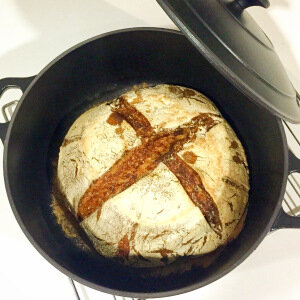Bread, silent word of a gesture of friendship
Bread, which fundamentally unites men and for which they wage war. The history of bread goes back at least 30,000 years. The first bread produced was probably cooked versions of a grain-paste, made from roasted and ground cereal grains and water, and may have been developed by accidental cooking or deliberate experimentation.
Bread, which fundamentally unites men
and for which they wage war
The history of bread goes back at least 30,000 years. The first bread produced was probably cooked versions of a grain-paste, made from roasted and ground cereal grains and water, and may have been developed by accidental cooking or deliberate experimentation with water and grain flour. Descendants of these early flatbreads are still commonly made from various grains in many parts of the world, including Armenian lavashs and Iranian sangaks, taboons, Mexican tortilla, Indian bread chapati, roti and naan, Scottish oatcake, North American johnnycake, Jewish Matzo, Middle Eastern pita, and Ethiopian injera. Flat bread of these types also formed a staple in the diet of many early civilizations with the Sumerians eating a type of barley flat cake, and the 12th century BC Egyptians being able to purchase a flat bread called ta from stalls in the village streets. The ritual bread in ancient Greek offerings to the chthonic gods, known as psadista was made of fine flour, oil and wine.
I love my bread. The only thing I like more than actually eating a good piece of bread, is making it. I don’t mean any old bread. No, it has to be a slow fermented sourdough. Best is when the grains are a bit mixed up. Some rye for the flavour, whole wheat for the wholesomeness, sometimes I use some heritage grains, if I can get my hands on some.
Making bread is an exercise of patience. It is not something you throw together, and voila … here it is. NO, making a decent sourdough takes the better part of a week, if you are not one of those people who have some on the ready at all times. And the process of fermenting the dough and waiting for it to turn into something so special, that songs, poems and prayers have been written about it, is a test well rewarded.
Various spreads to go with it are best home-made … naturally. My very own Chicken Liver Pate would do just nicely. If you can get over the cleaning of raw liver … but hey, … it tastes great!!
But it doesn’t have to be savoury, …
… a bit of good butter topped with a jam, like this Rose Jam, made by my friends in Lebanon. It had to travel half way around the world just to be united with some awesome bread, my bread, to be turned into … well … Dessert.
There are recipes floating through the internet, like this “No Knead Bread’ and similar. I came up with my own simple recipe based on the ‘lazy man’s bread’.
Thomas’ Rye-Whole Wheat Bread
125 g Dark Rye Flour
175 g Stone Ground Whole Wheat Flour
300 g Organic Bread Flour (get the good stuff)
15 g Sea Salt
125 g Sour Dough (100% Hydration)
3 g Instant Yeast (yes, I like a bit help there)
480 ml water (25°C) (80% hydration)
Optional: Caraway seeds, Fennel seeds
Sift the flour together
Add salt and yeast
Pour in the Sour dough and add the water
Use a rye sour dough or a wheat sour dough, experiment. I like a mixed sourdough for not to get the bread too sour.
Mix by hand or in a mixer until fully combined
Let rest for two hours in a plastic bowl, and mix again. Sprinkle a little flour on top and cover with a kitchen cloth.
Now, here come the variations … If I know for sure I will bake the next day, I let the dough rest at room temperature (25 – 28°C) for about 12 hours (sometimes a little more). Then, on a floured Bread flour and durum wheat semolina) work surface, work the dough a little. It will be quite sticky.
Fold it over from the sides, and then repeat from top to bottom and vice versa. You should be getting a decent ball of bread dough.
Place into wicker basket. Do not forget to flour it generously, cover with a cloth and let it raise again until it increased by about 50-75%. This can take somewhere from an hour to two and a half.
The other option would be to stick the dough into the refrigerator and leave it there for about 48 hours. Work it just the same and let it rise in your wicker basket. This method will give you a little more pronounced flavour.
While the bread is rising, heat your oven to at least 260°C. Use a baking stone. Metal baking trays will just not work.
I use a cast iron pot preheated to 260°C, including the lid.
When the bread dough has risen, and it still has enough ‘spring’ left, turn it onto the baking stone, place a baking tray underneath and pour a cup of water onto it for some steam.
Bake for 25 min. Let the steam escape and finish baking for an additional 30 min at 225°C, or until the loaf sound hollow when taped on the bottom.
If you use a cast iron pot, bake for 25 minutes with the closed lid, remove the lid and finish baking for another 30 min.
Let completely cool on wire rack
I usually, if I can stand it, let the bread sit in a paper bag (plastic bag will let the bread-crust go soft) until the next day for the flavours to ‘mingle’









